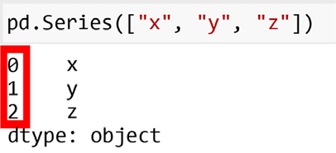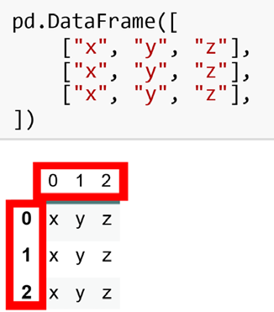Index
When constructing both the pd.Series and pd.DataFrame objects in the previous sections, you likely noticed the values to the left of these objects starting at 0 and incrementing by 1 for each new row of data. The object responsible for those values is the pd.Index, highlighted in the following image:

Figure 1.1: Default pd.Index, highlighted in red
In the case of a pd.DataFrame, you have a pd.Index not only to the left of the object (often referred to as the row index or even just index) but also above (often referred to as the column index or columns):

Figure 1.2: A pd.DataFrame with a row and column index
Unless explicitly provided, pandas will create an auto-numbered pd.Index for you (technically, this is a pd.RangeIndex, a subclass of the pd.Index class). However, it is very rare to use pd.RangeIndex for your columns, as referring to a column named City or Date is more expressive than referring to a column in the nth position. The pd.RangeIndex appears more commonly in the row index, although you may still want custom labels to appear there as well. More advanced selection operations with the default pd.RangeIndex and custom pd.Index values will be covered in Chapter 2, Selection and Assignment, to help you understand different use cases, but for now, let’s just look at how you would override the construction of the row and column pd.Index objects during pd.Series and pd.DataFrame construction.
How to do it
When constructing a pd.Series, the easiest way to change the row index is by providing a sequence of labels to the index= argument. In this example, the labels dog, cat, and human will be used instead of the default pd.RangeIndex numbered from 0 to 2:
pd.Series([4, 4, 2], index=["dog", "cat", "human"])
dog 4
cat 4
human 2
dtype: int64
If you want finer control, you may want to construct the pd.Index yourself before passing it as an argument to index=. In the following example, the pd.Index is given the name animal, and the pd.Series itself is named num_legs, providing more context to the data:
index = pd.Index(["dog", "cat", "human"], name="animal")
pd.Series([4, 4, 2], name="num_legs", index=index)
animal
dog 4
cat 4
human 2
Name: num_legs, dtype: int64
A pd.DataFrame uses a pd.Index for both dimensions. Much like with the pd.Series constructor, the index= argument can be used to specify the row labels, but you now also have the columns= argument to control the column labels:
pd.DataFrame([
[24, 180],
[42, 166],
], columns=["age", "height_cm"], index=["Jack", "Jill"])
age height_cm
Jack 24 180
Jill 42 166
































































